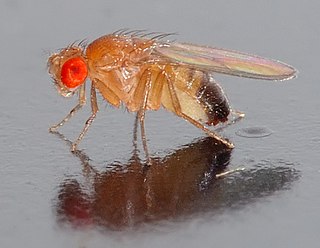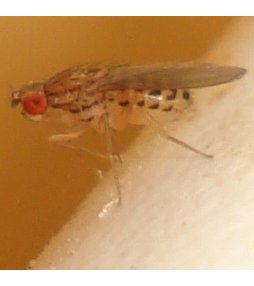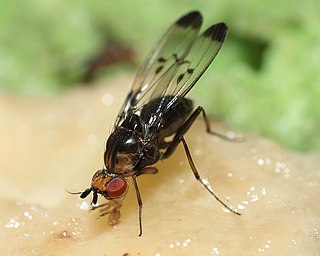
The Drosophilinae are the largest subfamily in the Drosophilidae. The other subfamily is the Steganinae.
The Drosophila melanogaster species group belongs to the subgenus Sophophora and contains 10 subgroups. The phylogeny in this species group is poorly known despite many studies covering many of the species subgroups. The most likely explanation is that the various subgroups diverged from each other in a relatively short evolutionary time frame. Three subgroups have not yet been investigated in molecular studies, and their position in the phylogeny is unclear. The suzukii subgroup is paraphyletic as D. lucipennis is systematically placed within the elegans subgroup.

The paraphyletic subgenus Sophophora of the genus Drosophila was first described by Alfred Sturtevant in 1939. It contains the best-known drosophilid species, Drosophila melanogaster. Sophophora translates as carrier (phora) of wisdom (sophos). The subgenus is paraphyletic because the genus Lordiphosa and the species Hirtodrosophila duncani are also placed within this subgenus.

The subgenus Dorsilopha belongs to genus Drosophila and consists of four species. The phylogenetic position of this group has been unclear for a long time, but recent studies have shown that the subgenus is positioned ancestral to the subgenus Drosophila.
The subgenus Dudaica belongs to genus Drosophila and consists of two species, Drosophila malayana and Drosophila senilis Duda, 1926.
Hirtodrosophila duncani is a North American fruit fly, a member of the fungus-breeding genus Hirtodrosophila. Its taxonomic position has been unclear for a long time due to its unique male genitalia, but recent molecular studies indicate that it is closely related to the New World Sophophora.
The Holarctic Drosophila populi species group belongs to the subgenus Sophophora and contains two species, Drosophila ingrica and Drosophila populi. D. ingrica is found in the Palearctic, while D. populi is found in the Nearctic. Both species are found in the northernmost subarctic forest zone, and are strongly associated with cottonwood trees.

The genus Zaprionus belongs to the family fruit fly Drosophilidae and is positioned within the paraphyletic genus Drosophila. All species are easily recognized by the white longitudinal stripes across the head and thorax. The genus is subdivided in two subgenera, based on the presence of an even or odd number of white stripes. The species of the genus can be found in Africa and Southern Asia. One species, Zaprionus indianus, has invaded the New World.
The Drosophila polychaeta species group is a species group of fruit flies in the subgenus Drosophila.

Drosophila appendiculata is a large yellowish fruitfly found in Southern Chile and neighboring Argentina. The species is placed in its own unique subgenus, Chusqueophila, based on the presence of three partial cross-veins in the wing.

Scaptomyza is a genus of vinegar flies, insects in the family Drosophilidae. As of 2022, there are 273 described species of Scaptomyza. Of those, 148 are endemic to the Hawaiian archipelago. This genus is part of the species-rich lineage of Hawaiian Drosophilidae, and is the sister lineage to the endemic Hawaiian Drosophila. The genus Scaptomyza is one of several nested within the paraphyletic genus Drosophila.
The Drosophila tripunctata species group is a species group of fruit flies in the subgenus Drosophila.

The Hawaiian Drosophilidae are a lineage of flies within the genus Drosophila. This monophyletic clade includes all of the endemic Hawaiian Drosophila and all members of the genus Scaptomyza, which contains both Hawaiian and non-Hawaiian species. The Hawaiian Drosophilidae are descended from a common ancestor estimated to have lived 25 million years ago. Species of Hawaiian Drosophilidae flies have been studied as models of speciation and behavioral evolution. Along with other members of the native Hawaiian ecosystem, the conservations status of many species of Hawaiian Drosophilidae is threatened by habitat loss and introduced predators, among other factors.
The Drosophila angor species group is a species group of fruit flies in the subgenus Drosophila.
The Drosophila robusta species group is a species group of fruit flies in the subgenus Drosophila.
The Drosophila melanica species group is a species group of fruit flies in the subgenus Drosophila.
The Drosophila quadrisetata species group is a species group of fruit flies in the subgenus Drosophila.
The Drosophila repleta species group is a species group of fruit flies in the subgenus Drosophila.
The Drosophila virilis species group is a species group of fruit flies in the subgenus Drosophila.
Drosophila aglaia is an endangered species of fly from Hawaii. This species is a member of the aglaia subgroup of the picture-wing clade of Hawaiian Drosophilidae. It is only found on the island of Oahu, and has not been observed since 1997, when it was found in Palikea.






